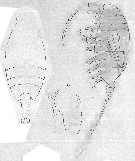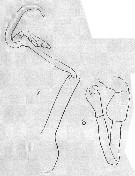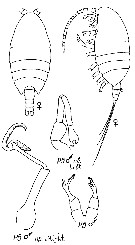|
|
 |
|
Calanoida ( Order ) |
|
|
|
Clausocalanoidea ( Superfamily ) |
|
|
|
Stephidae ( Family ) |
|
|
|
Stephos ( Genus ) |
|
|
| |
Stephos antarcticus Wolfenden, 1908 (F,M) | |
| | | | | | | Syn.: | Stephus antarcticum Wolfenden, 1908 (p.23, figs.F,M); 1911 (p.205, Rem.);
Stephus antarcticus : Sewell, 1948 (p.574) | | | | Ref.: | | | Bradford-Grieve, 1999 a (p.13, 25, Table 1: Rem.); Kos, 2016 (p.13, figs.F, M, Rem.) |  Issued from : R.N. Wolfenden in Natn. Antarct. Exped. 1901-1904, Nat. Hist., Zoology. 1908, 4. [Pl. V, 4-6]. As Stephus antarcticum.Female: 4, habitus (lateral); 5, same (dorsal); 6, P5. Nota : Cephalothorax about 3 times as long as abdomen, and in its broadest part distal of the middle line 1/3 as broad as long.Head evenly rounded, a little produced in front, without trace of rostrum. Head and 1st thoracic segment with a weak line indicating its division. Last two thoracic segments imperfectly divided, and last segment a little unsymmetrical ; on the right side a little longer than on the left, produced into a round-ended margin, on the left side more acutely pointed, which is most marked in lateral view. Abdomen 4-segmented. Genital segment laterally swollen in the upper part (genital protuberances) and again slightly swollen laterally in its lower part, with on each side a bunch of rather long spines, none dorsally. Caudal rami as long as the anal segment, and broad as long ; caudal rami with 4 setae on each side, outer margins haired and with, on each side, a short lateral spine instead of the usual bristle, and on the ventral side a very short accessory bristle ; of the bristles, the two middle ones are much the longest and thickest, and those of the right side more sot han those of the left. A1 24-segmented (8th and 9th segments fused), reaching to about the end of the 2nd abdominal segment. A2 exopod longer than the endopod. Md with rami of same length ; masticatory plate with strong teeth. Mx1 : basis with 5, exopodal segment with 10, 1st endopodal segment with 4, 2nd endopodal segment with 3, 3nd endopodal segment with 6 bristles, inner lobe 2 and 3 present, an douter lobe 1 with 8 bristles Mxp with 1st and 2nd basal and endopod in proportion of 24 : 11 : 20. P1 : endopod 1-segmented, exopod 3-segmented, without outer seta on the 1st exopodal segment. P2 with endopod 2-segmented and exopod 3-segmented. P3 and P4 have both rami 3-segmented. P5 right side a little longer than the left ; each 3-segmented, of which coxo and basis equal in size, but the last segment on the right le gis a little longer than the left one.. Each has terminally 3 spiny processes, the innermost comparatively thick, curved , and hook-like, and with hairs only on the outer margin ; the 2 outer spines are neither much more than half the length of the inner one, and only half as thick.
|
 Issued from : R.N. Wolfenden in Natn. Antarct. Exped. 1901-1904, Nat. Hist., Zoology. 1908, 4. [Pl. V, 7-8]. As Stephus antarcticum. Male: 7-8, P5. Nota ; The asymmetry of the last thoracic segment is only slight, and on neither side is it so prolonged as in the female. Abdomen 5-segmented ; the 1st segment is more laterally swollen than in the female, an is broader than long ; the 2nd and 3rd segments about equal in length, and much longer than the anal, which is very short. A1 24-segmented, reaching to about the end of the 2nd abdominal segment. Oral appendages and legs (except P5) are the same as in the female. P5 : right leg 4-segmented, left leg 5-segmented. In the right leg the 1st segment is short and rather broad, the 2nd elongated, rather longer and thicker than the 3rd, which is a long thin segment with club-shaped distal extremity, and having attached to the segment it makes with the last appendage a broad, rather triangular plate covered with fine hairs and a few rather strong spines ; the last segment is represented by a cvomparatively strong and large curved appendage, armed along its inner margin with short stiff bristles, these two terminal appendages resembling an awkward-looking pair of shears. In the left leg, the 1st and 2nd segments comparatively shorter but broader than the 3rd and 4th ; the 5th segment short and broad at the distalend, with externally a short curved tooth-like ending of the distal margin, anda t the inner end an upright knob-shaped aoppendage, strongly armed all over, and especially at the base of the stalk, with short stiff bristles.
|
 Issued from : M.S. Kos in Zoological Institut RAS, St. Petersburg, 2016, 179. [p.13, Fig. 1]. Stephos antarcticum female and male (Redrawn from Wolfenden, 1908).
| | | | | Compl. Ref.: | | | Razouls & al., 2000 (p.343, tab. 2, 5, Appendix); Park & Ferrari, 2009 (p.143, Table 1, fig.2, Appendix 1 biogeography) | | | | NZ: | 1 | | |
|
Distribution map of Stephos antarcticus by geographical zones
|
| | | | | | | Loc: | | | Antarct. (Indian: continent, McMurdo Sound)
Type locality: 68°07' S, 91°06' E. | | | | N: | 1 | | | | Lg.: | | | (32) F: 2-1,85; M: 1,75; {F: 1,85-2,00; M: 1,75} | | | | Rem.: | Sampling depth (Antarct.) : 100 m. Under the ice.
After Bradford-Grieve (1999 a, p.25) this species belongs to type I (see Genus Stephos). | | | Last update : 05/02/2019 | |
|
|
 Any use of this site for a publication will be mentioned with the following reference : Any use of this site for a publication will be mentioned with the following reference :
Razouls C., Desreumaux N., Kouwenberg J. and de Bovée F., 2005-2025. - Biodiversity of Marine Planktonic Copepods (morphology, geographical distribution and biological data). Sorbonne University, CNRS. Available at http://copepodes.obs-banyuls.fr/en [Accessed May 23, 2025] © copyright 2005-2025 Sorbonne University, CNRS
|
|
 |
 |






